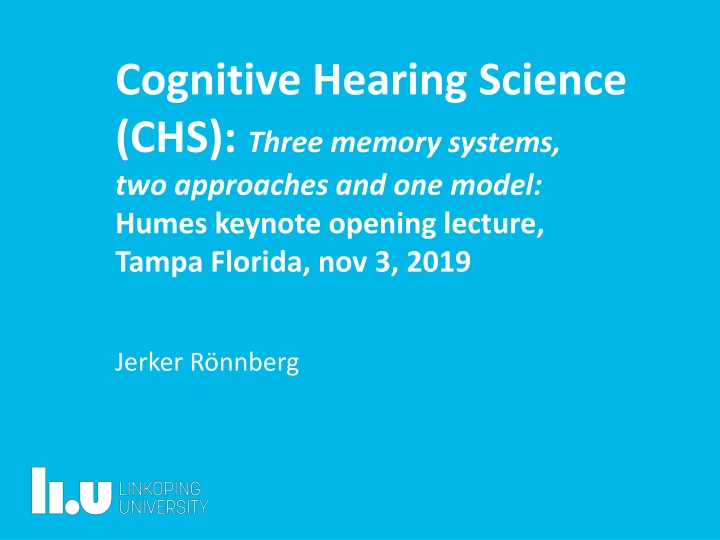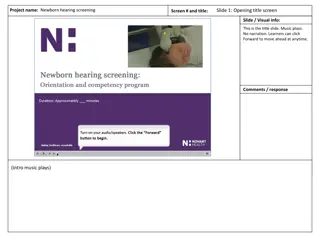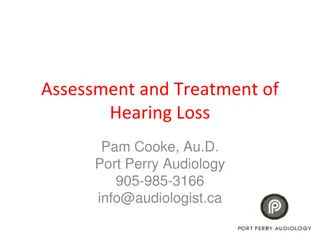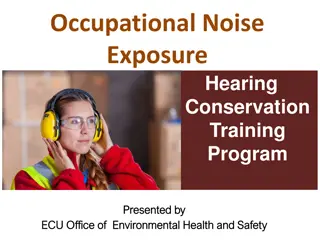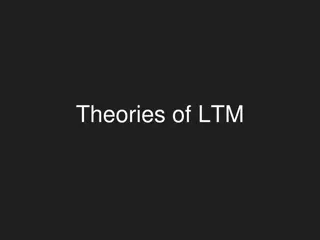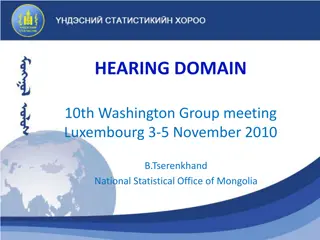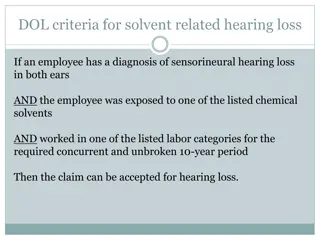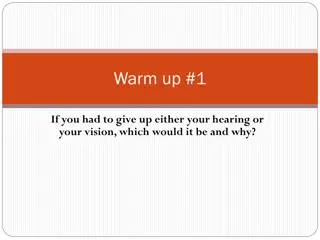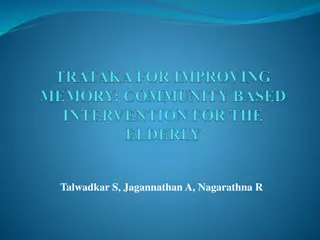Cognitive Hearing Science: Memory Systems & Approaches
Cognitive Hearing Science (CHS) explores memory systems and approaches in processing auditory information. Three memory systems - Episodic LTM, Semantic LTM, and Working Memory - play crucial roles in communication. The ELU framework focuses on Ease of Language Understanding, highlighting the importance of working memory in speech comprehension, especially for hearing-impaired individuals. The role of top-down processing in managing speech in noise conditions is also discussed.
Download Presentation

Please find below an Image/Link to download the presentation.
The content on the website is provided AS IS for your information and personal use only. It may not be sold, licensed, or shared on other websites without obtaining consent from the author.If you encounter any issues during the download, it is possible that the publisher has removed the file from their server.
You are allowed to download the files provided on this website for personal or commercial use, subject to the condition that they are used lawfully. All files are the property of their respective owners.
The content on the website is provided AS IS for your information and personal use only. It may not be sold, licensed, or shared on other websites without obtaining consent from the author.
E N D
Presentation Transcript
Cognitive Hearing Science (CHS): Three memory systems, two approaches and one model: Humes keynote opening lecture, Tampa Florida, nov 3, 2019 Jerker R nnberg
Cognitive Hearing Science (CHS): CHS focuses on the subtle balancing act between what we traditionally call bottom- up, signal-driven and top-down, conceptually driven information processing (Audibility/Cognitive factors, Humes, JAAA, 2007)
Visual analogy of hearing impairment: the power of top- down processing Cowboy
Social activity Or a panda ?
THREE MEMORY SYSTEMS Different memory systems play different communicative roles, and are part of top-down processing skills: Episodic long-term memory (Episodic LTM) is a personal memory system, dated in time and space. Semantic long-term memory (Semantic LTM) refers to general knowledge, without personal reference, e.g., scripts, vocabulary or phonology. Working memory (WM) refers to an individual s capacity to keep several things in mind, often involving storage of information, while doing some kind of semantic processing.
APPROACH I: WM system for Ease of Language Understanding (ELU) ELU-framework: R nnberg, 2003, Int J Audiol; R nnberg et al., 2008, Int J Audiol, R nnberg et al. 2010, Noise & H; R nnberg et al. 2011, JSHLR Main prediction: Under adverse, mismatching, speech-in- noise conditions, speech understanding depends on explicit processing and storage capacities such as working memory (WM), typically tapped by the reading span test.
Red: speech in noise Cognitive hearing, with increased mismatch (in red): Zekveld et al. (2012), Brain & Lang.
Examples of Approach I WM-dependence, especially for hearing- impaired participants and speech-like or speech babble backgrounds (e.g., Lunner, 2003; Ng et al., 2013; R nnberg et al., 2016; Marsja et al., 2019; Zekveld et al., 2019). When WM-dependence is reduced for acclimatization to one type of signal processing (e.g., SLOW compression in the hearing aid), then switching to FAST compression, causes phonological mismatch and higher dependence (Rudner et al., 2009; Souza et al., 2015, for a review).
Further examples of Approach I WM-dependent concentration/ attention processes at the brain stem and cortical levels (S rqvist et al., 2012; 2016).
Srqvist, Stenfelt & Rnnberg (2012) J Cog Neurosci 2012. (doi:10.1162/jocn_a_00275) . 1.2 Normalized magnitude of wave V [mV] 1.1 1 0.9 0.8 Active listening 1-back 2-back 3-back Condition
Concentration: a dynamic interplay S rqvist, Dahlstr m, Karlsson & R nnberg (2016). Frontiers in Hum Neuroscience. doi.org/10.3389/fnhum.2016.00221
Final example of Approach I S rqvist & R nnberg (2012). Journal of Speech, Language, and Hearing Research, 55, 210-218. High WMC gives reserve capacity for storing information in episodic LTM. SIC span: Is an elephant larger than a mouse? Zebra A good predictor of listening to a story in speech babble and Episodic LTM of what was said.
New ELU model: R, Holmer & Rudner, IJA, 2019; R et al., Front. Syst. Neurosci, 2013, R et al. IJA, 2016 Post-diction refers to reconstruction after mismatch Pre-diction refers implicit priming and pre-tuning via RAMBPHO Pre- and post both depend on WMC High WMC affects gist/understanding and reserve cpacity for episodic LTM.
APPROACH II: Plasticity PLASTICITY= The ELU-model predicts a relative disuse of episodic , multimodal LTM (ELTM) compared to WM, with neural consequences. Reason: WM is always used for postdiction, ELTM is used less because of fewer encodings/retrievals
Approach II:UK biobank (memory) N = 138 000, when age is controlled for, a measure of functional hearing (SRTs for reporting digits in noise at 50%) predicts a significant and negative effect on visual episodic LTM: cf. the ELU prediction of disuse of multimodal memory systems. Hearing aid use had very limited effects R nnberg J, Hygge S, Keidser G and Rudner M (2014). The effect of functional hearing loss and age on long- and visuospatial WM: Evidence from the UK Biobank resource. Front. Aging Neurosci. 6:326. doi: 10.3389/fnagi.2014.00326
UK biobank (morphological) In a large nonclinical cohort (n = 8,701, 52.6% female, 47.4% male) of middle-aged adults poorer SRTs a measure of functional hearing is related to lower gray matter volume in the whole brain and in predicted functional networks including the STG and frontal regions (not to parietal WM storage regions). SRTs is also related to reduced white matter volume in the hippocampus. > This is in line with the ELU. Rudner, M., Keidser, G., Johnsson, B., & R nnberg, J. (2019). Poorer speech reception threshold in noise is associated with lower brain volume in auditory and cognitive processing regions. Journal of Speech, Language, and Hearing Research. doi.org/10.1044/2018_JSLHR-H-ASCC7-18-01
Further example related to Further example related to Approach II Approach II Other international studies claim that hearing impairment causes dementia of Alzheimer type (e.g. Lin et al., 2011, longitudinal study).
Hypothesis We know that: 1. Cognitive aging: decline in episodic LTM is what is first affected in the development of dementia of the Alzheimer type 2. The same decline holds for functional hearing loss and is corroborated by the longitudinal Lin studies 3. Hearing loss is also connected to predicted morphological changes, Rudner et al. (2019). Thus, we have a hearing-related mechanism that is potentially connected to dementia of the Alzheimer type.
New ELU model: new data, some predictions and future 1. new kinds of signal processing and signal distortion draw on WMC (e.g. Arehart et al., 2013; Lunner et al., 2009; Foo et al., 2007). Even for high positive SNRs, WMC modulates short-term retention of spoken materials, the SWIR test (Ng et al., 2013; Souza et al., 2015). Future Research > task difficulty of SWIR, then signal processing more beneficial (Micula et al., (2019). 2. WMC is predicted to modulate early attention mechanisms ; brain stem data (S rqvist et al., 2012a; cf. Kraus & Chandrasakaren, 2010; Kraus et al., 2012). Future Res: WMC and attention with different intention, refinement of brain measures. 3. D-ELU model (Holmer et al., 2016) is about how Semantic LTM representations are formed. We will continue this track (Ng & R , 2019) 4. WMC seems relatively more robust than other LTM memory systems in response to impairment-related decline (R nnberg et al., 2011; R nnberg et al., 2014) Future Res: Departing from Rudner et al., (2019), we will investigate the hearing-loss-hippocampal-episodic LTM connection in one study.
New ELU model: Some future clinical projects 1. Develop clinically useful WMC tests (on-line and episodic LTM at the same time). 2. Using EEG signals for controlling the hearing aid, not just watching the speaker but using brain activity related to intention 3. Cognitive spare capacity: Episodic LTM for the contents of a conversation in noise 4. Longitudinal study, auditory/cognitive predictors of decline/dementia, n200 5. Intervention study: WM training > better SPIN performance, neural correlates
Thank you for listening! www.headcentre.se
